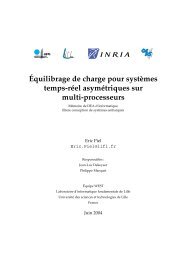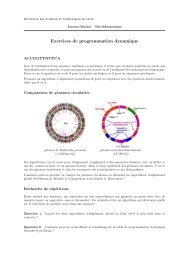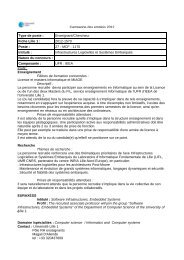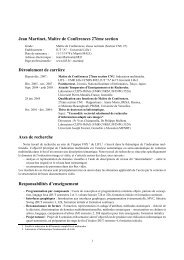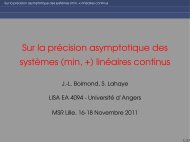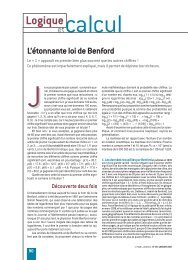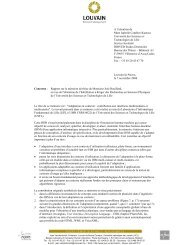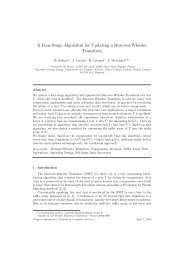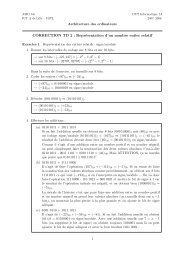Algorithmes de prediction et de recherche de multi-structures d'ARN
Algorithmes de prediction et de recherche de multi-structures d'ARN
Algorithmes de prediction et de recherche de multi-structures d'ARN
Create successful ePaper yourself
Turn your PDF publications into a flip-book with our unique Google optimized e-Paper software.
46 Chapter 3. Regliss – Locally optimal <strong>structures</strong> <strong>prediction</strong><br />
We now turn to the problem of the construction of all locally optimal secondary <strong>structures</strong><br />
for a s<strong>et</strong> of helices. From an algorithmic viewpoint, the two-step approach <strong>de</strong>scribed in Section<br />
3.2 is still relevant: First consi<strong>de</strong>ring <strong>structures</strong> maximal for juxtaposition and constructing<br />
them by dynamic programming, then recovering locally optimal secondary <strong>structures</strong> on the fly<br />
with a push-down stack. The main outline is unchanged. However, the algorithm presented in<br />
Section 3.2 needs some adaptation to take into account the existence of embed<strong>de</strong>d helices and<br />
the fact that some helices can combine to form other helices present in the input s<strong>et</strong>.<br />
We first explain how to construct <strong>structures</strong> maximal for juxtaposition in the context of<br />
<strong>structures</strong> formed by helices, and then how to <strong>de</strong>rive locally optimal secondary <strong>structures</strong>.<br />
3.3.2 Construction of <strong>structures</strong> maximal for juxtaposition<br />
The maximal for juxtaposition <strong>structures</strong> on H are maximal flat <strong>structures</strong>, similar to maximal<br />
for juxtaposition <strong>structures</strong> on BP in Definition 5 :<br />
Definition 9 (Maximal for juxtaposition on helices) Given a s<strong>et</strong> of helices H, and a structure<br />
F on H, F is maximal for juxtaposition if it satisfies the two following conditions:<br />
(i) if f and g are two distinct helices of F , then f and g are juxtaposed,<br />
(ii) if f is a helix of H not present in F such that {f} ∪ F is a secondary structure on H, then<br />
f is nested in some helix of F .<br />
As in Section 3.2, we <strong>de</strong>fine for each pair of helices f and g of H a s<strong>et</strong> of secondary <strong>structures</strong><br />
MJ(f, g) that contains all <strong>structures</strong> maximal for juxtaposition for H[f..g].<br />
1. If f.5start > g.3end, then MJ(f, g) = {ε}<br />
2. otherwise, if f.3end > g.3end, then MJ(f, g) = MJ(f + 1, g)<br />
3. otherwise<br />
MJ(f, g) = � � {f} ⊕ MJ(nextJuxt(f), g) (3a)<br />
Filter(f, MJ(f + 1, g)) (3b)<br />
Now ⊕ <strong>de</strong>notes the concatenation of a helix to a s<strong>et</strong> of <strong>structures</strong>, f + 1 <strong>de</strong>notes the next<br />
helix (wrt the helix or<strong>de</strong>ring �) after f and nextJuxt(f) <strong>de</strong>notes the smallest helix (wrt the helix<br />
or<strong>de</strong>ring �) juxtaposed with f. The <strong>de</strong>finition of Filter is a straightforward translation from<br />
Definition 6 on base pairs to helices.<br />
Definition 10 (Filter on helices) Given a helix h and a s<strong>et</strong> of secondary <strong>structures</strong> R on H,<br />
the secondary structure S of R is in Filter(h, R) if, and only if, there exists a helix h ′ in S such<br />
that h and h ′ are neither nested nor juxtaposed.<br />
We then have a result analogous to the Theorem 2. The proof is i<strong>de</strong>ntical.<br />
Theorem 3 For each pair of helices f and g of H, MJ(f, g) is exactly the s<strong>et</strong> of <strong>structures</strong><br />
maximal for juxtaposition on H[f..g].





